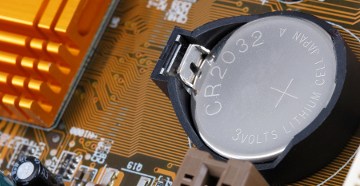
Lithium
Lithium General
| Name:Lithium | Symbol:Li |
| Type:Alkali Metal | Atomic weight:6.941 |
| Density @ 293 K:0.53 g/cm3 | Atomic volume:13.10 cm3/mol |
|
Discovered:
Lithium was discovered by Johan A. Arfvedson in 1817, during an analysis of petalite (LiAlSi4O10). In the petalite he described a substance that had unique properties and which required more acid to neutralize it than a sodium salt would have. The new metal differed from potassium because it did not give a precipitate with tartaric acid and, unlike sodium, its carbonate was only sparingly soluble. (1) The pure metal was isolated the following year by both William T. Brande and Humphry Davy working independently. Davy obtained a small quantity of lithium metal by electrolysis of lithium carbonate. He noted the new element had a red flame color somewhat like strontium and produced an alkali solution when dissolved in water. (2) In days less safety-conscious than the present, Brande noted of lithium, "its solution tastes acrid like the other fixed 'alkalies'". (3) By 1855 Robert Bunsen and Augustus Matthiessen were independently producing the metal in large quantities by the electrolysis of molten lithium chloride. Lithium's name is derived from the Greek word 'lithos', meaning, 'stone'. |
|
Lithium States
| State (s, l, g):solid | |
| Melting point: 453.69 K (108.54 °C) | Boiling point:1615 K (1347 °C) |
Lithium Energies
| Specific heat capacity:3.58 J g-1 K-1 | Heat of atomization:159 kJ mol-1 |
| Heat of fusion:3.00 kJ mol-1 | Heat of vaporization :147.1 kJ mol-1 |
| 1st ionization energy:520.2 kJ mol-1 | 2nd ionization energy:7298.1 kJ mol-1 |
| 3rd ionization energy:11815.0 kJ mol-1 | Electron affinity:59.63 kJ mol-1 |
Lithium Oxidation & Electrons
| Shells:2,1 | Electron configuration: [He] 2s1 |
| Minimum oxidation number: -1 | Maximum oxidation number:1 |
| Min. common oxidation no.:0 | Max. common oxidation no.:1 |
| Electronegativity (Pauling Scale):0.98 | Polarizability volume:24.3 Å3 |
Lithium Appearance & Characteristics
| Structure:bcc: body-centered cubic | Color:silvery |
| Hardness:0.6 mohs | |
|
Harmful effects:
Lithium is corrosive, causing skin burns as a result of the caustic hydroxide produced in contact with moisture. Women taking lithium carbonate for bi-polar disorder may be advised to vary their treatment during pregnancy as lithium may cause birth defects. |
|
|
Characteristics:
Lithium is soft and silvery white and it is the least dense of the metals. It is highly reactive and does not occur freely in nature. Freshly cut surfaces oxidize rapidly in air to form a black oxide coating. It is the only common metal (but see radium) that reacts with nitrogen at room temperature, forming lithium nitride. Lithium burns with a crimson flame, but when the metal burns sufficiently well, the flame becomes a brilliant white. Lithium has a high specific heat capacity and it exists as a liquid over a wide temperature range. Uses: Pure lithium metal is used in rechargeable lithium ion batteries and the metal is used as an alloy with aluminum, copper, manganese, and cadmium to make high performance aircraft parts. Lithium also has various nuclear applications, for example as a coolant in nuclear breeder reactors and a source of tritium, which is formed by bombarding lithium with neutrons. Lithium carbonate is used as a mood-stabilizing drug. Lithium chloride and bromide are used as desiccants. Lithium stearate is used as an all-purpose and high-temperature lubricant. |
|
Lithium Reactions
| Reaction with air:vigorous,⇒Li2O | Reaction with 6 M HCl:vigorous,⇒ H2, LiCl |
| Reaction with 15 M HNO3:vigorous,⇒ LiNO3 | Reaction with 6 M NaOH:mild,⇒ H2, LiOH |
Lithium Compounds
| Oxide(s): Li2O | Chloride(s): LiCl |
| Hydride(s):LiH |
Lithium Radius
| Atomic radius:145 pm | Ionic radius (1+ ion):90 pm |
| Ionic radius (2+ ion):pm | Ionic radius (3+ ion):pm |
| Ionic radius (2- ion):pm | Ionic radius (1- ion):pm |
Lithium Conductivity
| Thermal conductivity:84.8 W m-1 K-1 | Electrical conductivity:11.7 x 106 S cm-1 |
Lithium Abundance & Isotopes
| Abundance earth's crust:20 parts per million by weight, 60 parts per million by moles | |
| Abundance solar system:60 parts per trillion by weight, 10 parts per trillion by moles | |
| Cost, pure:$27 /100g | |
| Cost, bulk:$9.50 /100g | |
|
Source:
Lithium does not occur as a free element in nature. It is found in small amounts in ores from igneous rocks and in salts from mineral springs. Pure lithium metal is produced by electrolysis from a mixture of fused (molten) lithium chloride and potassium chloride. |
|
|
Isotopes:
Lithium has 7 isotopes whose half-lives are known, with mass numbers 5 to 11. Of these, two are stable: 6Li and 7Li. |
|
Lithium Other
|
Other:
References |
|
Prev: Helium Next: Beryllium |